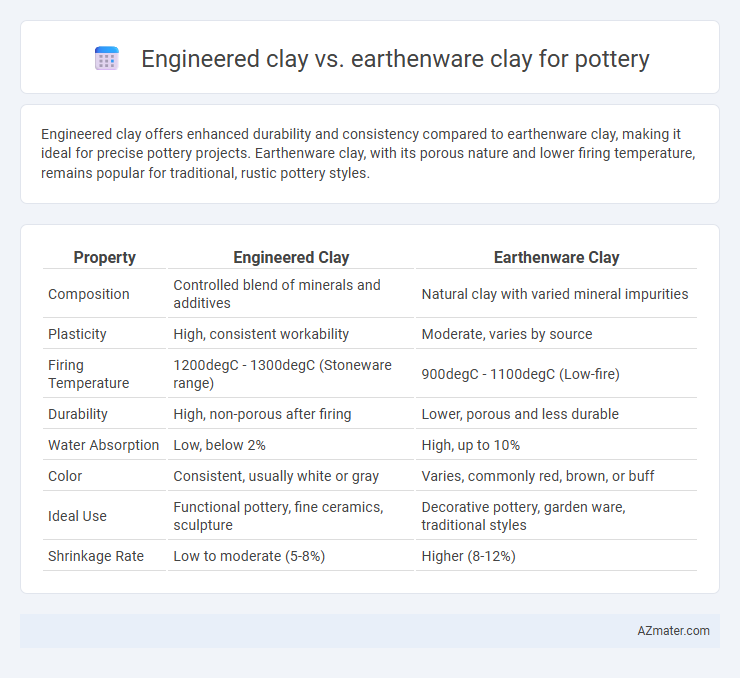Engineered clay offers enhanced durability and consistency compared to earthenware clay, making it ideal for precise pottery projects. Earthenware clay, with its porous nature and lower firing temperature, remains popular for traditional, rustic pottery styles.
Table of Comparison
| Property | Engineered Clay | Earthenware Clay |
|---|---|---|
| Composition | Controlled blend of minerals and additives | Natural clay with varied mineral impurities |
| Plasticity | High, consistent workability | Moderate, varies by source |
| Firing Temperature | 1200degC - 1300degC (Stoneware range) | 900degC - 1100degC (Low-fire) |
| Durability | High, non-porous after firing | Lower, porous and less durable |
| Water Absorption | Low, below 2% | High, up to 10% |
| Color | Consistent, usually white or gray | Varies, commonly red, brown, or buff |
| Ideal Use | Functional pottery, fine ceramics, sculpture | Decorative pottery, garden ware, traditional styles |
| Shrinkage Rate | Low to moderate (5-8%) | Higher (8-12%) |
Introduction to Engineered Clay and Earthenware Clay
Engineered clay is a refined, highly controlled material designed for consistent plasticity, strength, and reduced impurities, making it ideal for precise pottery applications. Earthenware clay, a traditional, naturally occurring clay rich in iron and other minerals, fires at lower temperatures and is porous and less durable than engineered clay. Understanding the distinct properties of engineered and earthenware clay helps potters select the right material for functional and decorative ceramic pieces.
Composition Differences: Engineered vs. Earthenware Clay
Engineered clay is formulated with precise blends of plasticizers, grog, and fluxing agents to optimize workability and firing properties, resulting in consistent texture and reduced shrinkage. Earthenware clay, composed primarily of natural clay minerals mixed with varying amounts of sand and organic matter, tends to have higher porosity and lower firing temperatures. These compositional distinctions influence durability, color retention, and firing ranges, making engineered clay more suitable for precision ceramics and earthenware preferable for traditional pottery with rustic aesthetics.
Workability and Handling: Which Clay Suits Your Style?
Engineered clay offers superior workability with consistent plasticity and smoother texture, making it ideal for precision pottery and intricate detailing. Earthenware clay, known for its coarse texture and lower plasticity, provides a rustic feel and better grip, preferred by artists who enjoy hand-building techniques and organic forms. Choosing between engineered and earthenware clay depends on your style: refined, delicate work benefits from engineered clay while earthy, tactile pieces excel with earthenware.
Firing Temperatures and Kiln Requirements
Engineered clay typically requires higher firing temperatures, usually between 1,200degC to 1,300degC, making it suitable for stoneware and porcelain production that demands durable, vitrified finishes. Earthenware clay fires at lower temperatures, around 1,000degC to 1,150degC, resulting in a more porous and less dense ceramic ideal for decorative and low-fired functional pieces. Kiln requirements for engineered clay include higher heat resistance and precise temperature control, while earthenware clay can be fired in lower-temperature kilns with less stringent atmosphere regulation.
Durability and Strength: Finished Pottery Comparison
Engineered clay offers superior durability and strength compared to earthenware clay, making it ideal for functional pottery that requires enhanced resistance to chipping and cracking. Earthenware clay, while easier to work with and fired at lower temperatures, results in more porous and less robust finished pieces prone to breakage under stress. The higher firing temperature and refined composition of engineered clay produce denser, more durable ceramics suitable for everyday use and long-term durability.
Surface Quality and Glaze Compatibility
Engineered clay offers a smooth, consistent surface ideal for precise detailing and uniform glaze application, ensuring enhanced aesthetic quality in pottery. Earthenware clay typically features a coarser texture with natural impurities, which can create a rustic, organic finish but may challenge glaze adhesion and smoothness. Glaze compatibility is higher in engineered clay due to its controlled composition, while earthenware requires specific glazes formulated for lower firing temperatures and porous surfaces.
Color and Texture Variations
Engineered clay offers consistent color and texture due to its uniform composition, making it ideal for precise, repeatable pottery work. Earthenware clay displays natural variations in color, ranging from red to brown or buff, influenced by regional mineral content and firing conditions. Texturally, earthenware tends to be coarser and more porous compared to the smooth, fine-grained finish of engineered clay.
Cost and Availability in the Market
Engineered clay often incurs higher costs due to specialized processing and additives designed to enhance durability and workability, making it less accessible for casual potters compared to earthenware clay. Earthenware clay is widely available and more affordable, sourced commonly from natural deposits with minimal processing, which suits beginners and budget-conscious artisans. Market availability favors earthenware clay with numerous suppliers and local options, whereas engineered clay may require purchase from specialty retailers or suppliers catering to advanced ceramics.
Environmental Impact and Sustainability
Engineered clay often involves synthetic additives and industrial processing, resulting in higher energy consumption and increased carbon emissions compared to earthenware clay, which is predominantly natural and minimally processed. Earthenware clay's biodegradable properties and local sourcing significantly reduce environmental impact, promoting sustainability in pottery production. Choosing earthenware clay supports lower resource depletion and favors eco-friendly disposal, aligning with environmentally conscious ceramic art practices.
Choosing the Best Clay for Your Pottery Project
Engineered clay offers consistent texture, controlled shrinkage, and higher durability, making it ideal for precise, detailed pottery projects requiring uniform results. Earthenware clay provides natural warmth and rustic appeal with its porous, lower firing temperature properties, perfect for decorative pieces or beginner potters seeking easy workability. Prioritize project goals, firing temperature compatibility, and desired finish when choosing between engineered clay and earthenware to achieve the best pottery outcomes.

Infographic: Engineered clay vs Earthenware clay for Pottery
 azmater.com
azmater.com